KINGS UNIT I QUESTION BANK
advertisement
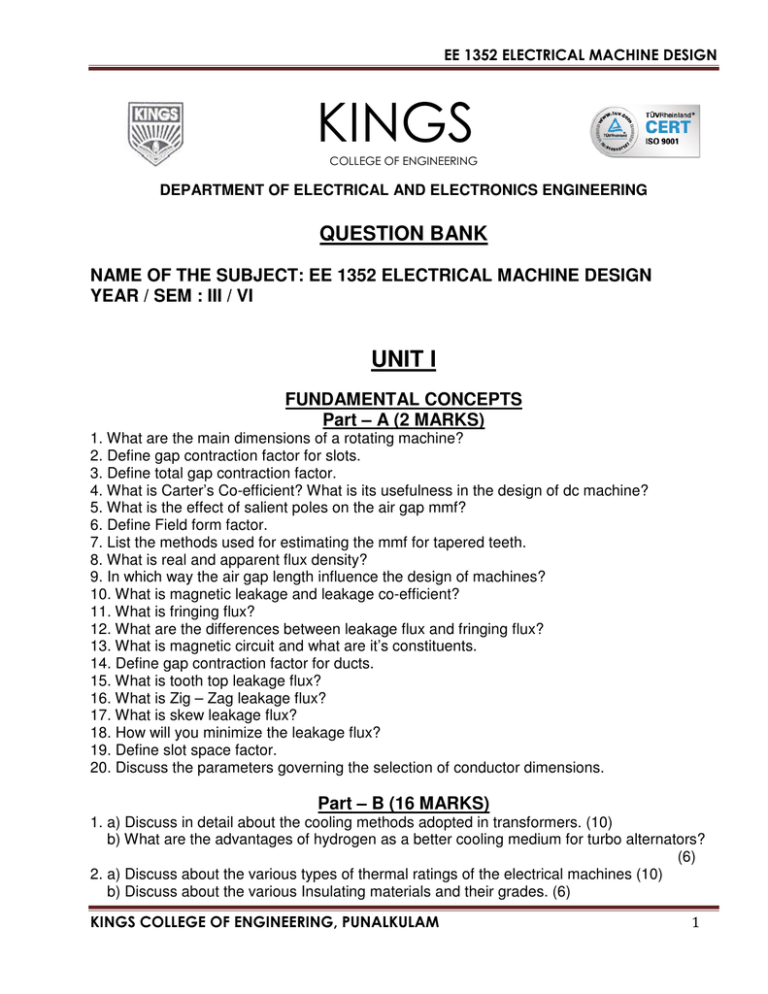
EE 1352 ELECTRICAL MACHINE DESIGN KINGS COLLEGE OF ENGINEERING DEPARTMENT OF ELECTRICAL AND ELECTRONICS ENGINEERING QUESTION BANK NAME OF THE SUBJECT: EE 1352 ELECTRICAL MACHINE DESIGN YEAR / SEM : III / VI UNIT I FUNDAMENTAL CONCEPTS Part – A (2 MARKS) 1. What are the main dimensions of a rotating machine? 2. Define gap contraction factor for slots. 3. Define total gap contraction factor. 4. What is Carter’s Co-efficient? What is its usefulness in the design of dc machine? 5. What is the effect of salient poles on the air gap mmf? 6. Define Field form factor. 7. List the methods used for estimating the mmf for tapered teeth. 8. What is real and apparent flux density? 9. In which way the air gap length influence the design of machines? 10. What is magnetic leakage and leakage co-efficient? 11. What is fringing flux? 12. What are the differences between leakage flux and fringing flux? 13. What is magnetic circuit and what are it’s constituents. 14. Define gap contraction factor for ducts. 15. What is tooth top leakage flux? 16. What is Zig – Zag leakage flux? 17. What is skew leakage flux? 18. How will you minimize the leakage flux? 19. Define slot space factor. 20. Discuss the parameters governing the selection of conductor dimensions. Part – B (16 MARKS) 1. a) Discuss in detail about the cooling methods adopted in transformers. (10) b) What are the advantages of hydrogen as a better cooling medium for turbo alternators? (6) 2. a) Discuss about the various types of thermal ratings of the electrical machines (10) b) Discuss about the various Insulating materials and their grades. (6) KINGS COLLEGE OF ENGINEERING, PUNALKULAM 1 EE 1352 ELECTRICAL MACHINE DESIGN 3. a) Explain in detail about the MMF calculation for tapered Teeth. (10) b) Discuss in detail about the real and apparent flux densities. (6) 4. a) Write about specific magnetic loading and specific electric loading. (8) b) Explain about the cooling of Turbo alternators. (8) 5. a) What are the direct and indirect cooling methods used in electrical machines (8) b) Derive an equation for the slot leakage reactance (8) 6. a) Discuss in detail about the unbalance magnetic pull. (8) b) Explain about the air gap reluctances in different types of armature slots (8) UNIT II DC MACHINES Part – A (2 MARKS) 1. Define specific magnetic loading. 2. Define specific electric loading. 3. What is output equation? 4. Write the expressions for output coefficients 5. List the factors that influence the separation of D and L of a dc machine. 6. What is square pole criterion? 7. List the various L/_ ratios used for separation of D and L in induction motor. 8. In a dc machine what are the limiting values of armature diameter? 9. What is un-balanced magnetic pull and how its ill-effects can be overcome? 10. What are the factors that affect the size of rotating machines? 11. What are the factors that decide the choice of specific magnetic loading? 12. .What are the factors that decide the choice of specific electric loading? 13. What is magnetization curve? 14. What are the factors that modify the reluctance of air gap 15. What are the problems encountered in estimating the mmf for teeth? 16. What factor decides the number of turns in a winding? 17. How the area of cross-section of a conductor is estimated? 18. What are the ranges of specific magnetic loading and specific electric loading in dc machine? 19. What are the factors to be considered for the selection of number of poles in a dc machine? 20. What are the parameters that are affected by the number of poles? 21. List the advantages and disadvantages of large number of poles. 22. Why square pole is preferred? 23. State the difference between the armature winding of dc machine and the stator winding of ac machine. 24. Define winding pitch. 25. What is back pitch? 26. What is front pitch? 27. Define commutator pitch. 28. What is equalizer connection? 29. What are the factors to be considered for estimating the length of air gap in dc machines? KINGS COLLEGE OF ENGINEERING, PUNALKULAM 2 EE 1352 ELECTRICAL MACHINE DESIGN 30. What are the effects of armature reaction? 31. How the polarities of inter pole are decided. 32. What is the effect of interpole on main pole? 33. What is the fundamental requirement of a good insulating material? 34. What is the importance of temperature as a factor in the life of insulating materials? 35. Why mineral insulating oils are the most widely used liquid insulation. 36. Why large size machines have large rating time constant? 37. Why ac armature winding is always made short-pitched. 38. Why equalizer connections are necessary for the armature winding of a dc machine with lap winding. 39. Why the voltage wave form of an ac armature winding contains harmonics. ? 40. Why the conductor eddy current loss increases if embedded deeper in the slot. Part – B (16 MARKS) 1. a) A 4 pole, 25 HP, 500 V, 600 rpm series motor has an efficiency of 82%. The pole faces are square and the ratio of pole arc to pole pitch is 0.67. Take Bav = 0.58 Wb/m2 and ac = 17000 amp.cond/m. Obtain the main dimensions of the core. (12) b) Enumerate the procedure for shunt field design (4) 2. a) A 4 pole, 400 V, 960 rpm, shunt motor has an armature of 0.3 m in diameter and 0.2 m in length. The commutator diameter is 0.22 m. Give full details of a suitable winding including the number of slots, number of commutator segments and number of conductors in each slot for an average flux density of approximately 0.55wb/m2Wb / m2 in the air gap. (12) b) Find the main dimension and number of poles of a 37 kW, 230V, 1400 rpm, shunt motor so that a square pole face is obtained. The average gap density is 0.5 wb/m2 and the ampere conductors / meter are 22000. The ratio of pole arc to pole pitch is 0.7 and the full load efficiency is 90% (4) 3. i) Derive the out put equation of a DC machine. (10) ii) Distinguish between lap winding and wave winding. (6) 4. i) Determine the total commutator losses for a 1000kw, 500V, 800rpm, 10 poles generator. Given that commutator diameter is 1.0m, current density at brush contact =75x10-3 A/mm2 brush pressure = 14.7kv/ m2, co efficiency of friction = 0.28, brush contact drop= 2.2V. (10) ii) Discuss the significance of specific loadings in the design of DC machines. (6) 5. i) Design a suitable commutator for a 350kw, 600rpm, 440V, 6poles DC generator having an armature diameter of 0.75m. The number of slots is 288. Assume suitable values where it’s necessary? (10) ii) Discuss the choice of poles and speed in DC machine. (6) 6. i) List out the procedure involved in design of shunt field winding and series field winding? (10) ii) Find the main dimension and number of poles of a 37 kW, 230V, 1400 rpm, shunt generator so that a square pole face is obtained. The average gap density is 0.7 wb/m2 and the ampere conductors / meter are 25000. The ratio of pole arc to pole pitch is 0.7 and the full load efficiency is 90 % (6) 7. Determine the shunt field winding of a 6-pole, 440V, dc generator allowing a drop of 15 % in the regulator. The following design date are available, mmf per pole = 7200 AT; mean length of turn = 1.2 m; winding depth = 3.5 cm; watts per sq.cm. of cooling surface = 650. KINGS COLLEGE OF ENGINEERING, PUNALKULAM 3 EE 1352 ELECTRICAL MACHINE DESIGN Calculate the inner, outer and end surfaces of the cylindrical field coil for cooling. Take diameter of the insulated wire to be 0.4 mm greater than the bare wire. Assume 2 micro – ohm / cm as the resistivity of copper at the working temperature. (16) 8. Determine the diameter and length of armature core for a 55kW, 110V, 1000 rpm, 4 pole shunt generator, assuming specific electric and magnetic loadings of 26000 amp.cond. / m and 0.5 Wb / m2 respectively. The pole arc should be about 70% of pole pitch and length of core about 1.1 times the pole arc. Allow 10 ampere for the field current and assume a voltage drop of 4 volts for the armature circuit. Specify the winding to be used and also determine suitable values for the number of armature conductors and slots. (16) UNIT III TRANSFORMERS Part – A (2 MARKS) 1. What is the cause of noise in transformer? 2. Why the area of yoke in a transformer is kept 15-20% more than that of core? 3. What are the salient features of a distribution transformer? 4. In transformers, why the low voltage winding is placed near the core? 5. Why circular coils are preferred in transformers? 6. What are the advantages and disadvantages of stepped cores? 7. What do you mean by stacking factor? What is its usual value? 8. What is tertiary winding? 9. List the different methods of cooling of transformers. 10. How the heat dissipation is improved by the provision of cooling tubes? 11. In mines applications transformer with oil cooling should not be used why? 12. What are the important properties of steel used in transformer core? 13. What are the advantages and disadvantages of using higher flux density in the core? 14. Why the cross section of yoke is taken greater than core section. 15. What are the types of windings, commonly used for LV winding. 16. What are the draw backs of sandwich winding? 17. Name a few insulating materials that are used in transformers. 18. How iron losses occurring in transformers can be minimized. 19. Mention clearly the condition for maximum efficiency for a transformer 20. Why the efficiency of a transformer is so high? 21. Mention the main function of cooling medium used in transformers. Part – B (16 MARKS) 1. i) Estimate the main dimensions including winding conductor area of a 3 phase delta-star core type transformer rated at 300KVA, 6600/400 V, 50 Hz. A suitable core with 3 steps having a circumscribing circle of 0.25m diameter and leg spacing of 0.4 m is available. EMF / turn = 8.5 V, _ = 2.5 A /mm2, kw= 0.28 and Sf = 0.9 (stacking factor) (10) ii) Derive the output equation of a single phase transformer. (6) 2. i) Determine the main dimensions of the core, the number of turns, the cross sectional area of conductors in primary and secondary windings of a 100 kVA, 2200/480 V, 1-phase, core type transformer, to operate at a frequency of 50 Hz, by assuming the following data. KINGS COLLEGE OF ENGINEERING, PUNALKULAM 4 EE 1352 ELECTRICAL MACHINE DESIGN Approximate volt per turn = 7.5 volt. Maximum flux density = 1.2 Wb / m2. ratio of effective cross – sectional area of core to square of diameter of circumscribing circle is 0.6. Ratio of height to width of window is 2. Window space factor = 0.28. Current density = 2.5 A/mm2. (10) ii) Explain how to estimate the no-load current of a three phase transformer. (6) 3. i) A 250 kVA, 6600 / 400 V, 3-phase core type transformer has a total loss of 4800 watts on full load. The transformer tank is 1.25 m in height and 1 m x 0.5 m in plan. Design a suitable scheme for cooling tubes if the average temperature rise is to be limited to 35°C. The diameter of the tube is 50 mm and are spaced 75 mm from each other. The average height of the tube is 1.05 m. (10) ii) Describe about the effect of frequency on Iron losses. (6) 4. i) Derive the voltage per turn equation of a transformer. (8) ii) Discuss about the various methods of cooling of power transformer. (8) 5. i) Determine the core and yoke dimensions for a 250 kVA, 50Hz, single phase, core type transformer, Emf per turn = 12 V, the window space factor = 0.33, current density = 3A / mm2 and Bmax = 1.1 T. The distance between the centers of the square section core is twice the width of the core. (6) ii) Calculate the dimensions of the core, the number of turns and cross sectional area of conductors in the primary and secondary windings of a 250 kVA, 6600 / 400 V, 50 Hz, single phase shell type transformer. Ratio of magnetic to electric loadings = 560 x 10-8, Bm = 1.1 T, _ = 2.5 A / mm2, Kw = 0.32, Depth of stacked core / width of central limb = 2.6; height of window / width of window = 2.0. (10) 6. i) A 375 kVA, single phase core type transformer operating on 6.6 kV / 415V is to be designed with approximately 7.5V per turn and a flux density of 1.1 T. Design a suitable core section and yoke section using two sizes of stampings. The width of smaller stampings may be approximately 0.62 times the larger stampings. State the assumptions made. (6) ii) The tank of a 500 kVA, 50Hz, 1-phase, core type transformer is 1.05 x 0.62 x 1.6 m high. The mean temperature rise is limited to 35°C. The loss dissipating surface of tank is 5.34 m2. Total loss is 5325 W. Find the area of tubes and number of tubes needed. (10) 7. The tank of 1250 kVA, natural oil cooled transformer has the dimensions length, width and height as 0.65 x 1.55 x 1.85 m respectively. The full load loss = 13.1 kW, loss dissipation due to radiations = 6 W / m2-°C, loss dissipation due to convection = 6.5 W / m2°C, improvement in convection due to provision of tubes = 40%, temperature rise = 40°C, length of each tube = 1m, diameter of tube = 50mm. Find the number of tubes for this transformer. Neglect the top and bottom surface of the tank as regards the cooling. (16) UNIT IV THREE PHASE INDUCTION MOTORS Part-A (2 marks) 1. Why does induction motor designed with high specific electric loadings have smaller over load capacity? 2. Why the harmonic leakage flux in squirrel cage induction rotor is not present? 3. Why the length of air gap in induction motor is kept minimum possible? KINGS COLLEGE OF ENGINEERING, PUNALKULAM 5 EE 1352 ELECTRICAL MACHINE DESIGN 4. Why do die-cast rotors is extensively used in making 3 phase cage induction motor? 5. Why do 3 phase squirrel cage induction motor finds wide application in industry? 6. What is hot spot temperature? 7. What is the advantage of having wound rotor construction? 8. What is rotating transformer? 9. What is integral slot winding and fractional slot winding? 10. What types of slots are preferred in induction motor? 11. List the undesirable effects produced by certain combination of rotor and stator slots. 12. What are the advantage and disadvantage of large air gap length in induction motor? 13. What are the factors which influence the power factor of an induction motor? 14. What are the criteria used for the choice for number of slots of an induction machine? 15. What are the factors to be considered for estimating the length of air gap in induction motor? 16. List out the methods to improve the power factor of an induction motor? 17. Why the air gap of an induction motor is made as small as possible? 18. What happens if the air-gap of an induction motor is doubled? 19. What is the condition for obtaining the maximum torque in case of 3 phase induction motor? 20. What are the special features of the cage rotor on induction machine? . Part-B (16 Marks) 1. Estimate the main dimension, air gap length, stator slots, slots / phase and cross sectional area of stator and rotor conductors for three phase, 15HP, 400V, 6 pole, 50Hz, 975 rpm induction motor. The motor is suitable for star – delta starting. Bav = 0.45 wb/m2. ac = 20000 AC/m. L / _ = 0.85. _ = 0.9 , P.F = 0.85. (16) 2. A 15 kW, three phase, 6 pole, 50 Hz, squirrel cage induction motor has the following data, stator bore dia = 0.32m, axial length of stator core = 0.125 m, number of stator slots = 54, number of conductor / stator slot = 24, current in each stator conductor = 17.5 A, full load P.F = 0.85 lag. Design a suitable cage rotor giving number of rotor slots section of each bar and section of each ring. The full speed is to be 950 rpm, use copper for rotor bar and end ring conductor. Resistivity of copper is 0.02 _m. (16) 3. A 90 kW, 500V, 50 Hz, three phase, 8 pole induction motor has a star connected stator winding accommodated is 63 slots with a 6 conductors / slot. If slip ring voltage, an open circuit is to be about 400V at no load find suitable rotor winding. Calculate number of rotor slots, number conductors / slot, coil span, number of slots per pole. P.F = 0.9 and the efficiency is 0.85 (16) 4. Determine the approximate diameter and length of stator core, the number of stator slots and the number of conductors for a 20 kW, 400V, 3 phase, 4pole, 1200rpm, delta connected induction motor. Bav =0.5T, _ = 0.82, ac = 26,000 amp.cond/m, power factor = 0.8, L/_ = 1, double layer stator winding. (16) 5. 6. Estimate the main dimensions, air-gap length, stator slots, stator turns per phase and cross sectional area of stator and rotor conductors for 3 phase, 110 kW, 3300V, 50 Hz, 10 poles, 600 rpm, Y connected induction motor, Bav = 0.48 Wb/m2, ac = 28,000 amp.cond/m, L/_ = 1.25, _ = 0.9, power factor = 0.86. (16) 7. Design a cage rotor for a 18.8HP, 3phase, 440V, 50Hz, 1000rpm, induction motor having KINGS COLLEGE OF ENGINEERING, PUNALKULAM 6 EE 1352 ELECTRICAL MACHINE DESIGN full load efficiency of 0.86, power factor = 0.86, D=0.25m, L=0.14m, Zss/Ss= 54. Assume missing data if any. (16) UNIT V SYNCHRONOUS MACHINES Part – A (2 MARKS) 1. State three important features of turbo alternator rotors. 2. Why salient pole construction is rejected for high speed alternators. 3. What material user for the construction of turbo alternator rotor. 4. What is run-away speed? 5. What is approximately the run away speed of Kaplan turbine. 6. Write the expression for the output coefficient of synchronous machine. 7. What are the advantages of designing the alternators with higher flux density?. 8. What are the disadvantages of designing the alternators with higher gap flux density? 9. Why semi- closed slots are generally preferred for the stator of induction motors. 10. What is the effect of specific magnetic loading on the size of the machine? 11. What is the effect of specific electric loading on t he copper losses? 12. Write down the main consideration in the selection of specific loadings for the design of induction motor. 13. What is critical speed of alternator? 14. What are the functions of damper winding? 15. What is Short Circuit Ratio (SCR)? 16 What is the effect of SCR on synchronous machine performance? 17. Why it is necessary to cool an electrical machine? 18. What is limiting factor for the diameter of synchronous machine? 19. Discuss how ventilation and cooling of a large high speed alternator is carried out. 20. Mention the factors to be considered for the design of field system in alternator. Part – B (16 Marks) 1. Determine the main dimension for 1000 kVA, 50 Hz, three phase, 375 rpm alternator. The average air gap flux density = 0.55 wb/m2 and ampere conductors / m = 28000. Use rectangular pole. Assume a suitable value for L / _ in order that bolted on pole construction is used for which machine permissible peripheral speed is 50 m/s. The runway speed is 1:8 times synchronous speed. (16) 2. Find main dimension of 100 MVA, 11 kV, 50 Hz, 150 rpm, three phase water wheel generator. The average gap density = 0.65 wb/m2 and ampere conductors / m are 40000. The peripheral speed should not exceed 65 m/s at normal running speed in order to limit runaway peripheral speed. (16) 3. Determine suitable number of slots conductors / slot for stator winding of three phase, 3300V, 50 Hz, 300 rpm alternator, the diameter is 2.3m and axial length of core = 0.35 m. Maximum flux density in air gap should be approximately 0.9 wb / m2. Assume sinusoidal flux distribution use single layer winding and star connection foe stator. (16) 4. Determine for 500kVA, 6600V, 20Hz, 500 rpm and connected three phase salient KINGS COLLEGE OF ENGINEERING, PUNALKULAM 7 EE 1352 ELECTRICAL MACHINE DESIGN pole machine diameter, core length for square pole face number of stator slots and number of stator conductors for double layer winding. Assume specific magnetic loading = 0.68 tesla, ac = 30000 AC/m and Kws = 0.955. (16) 5. A 1000 kVA, 3300V, 50Hz, 300 rpm, three phase alternator has 180 slots with 5 conductors / slot ,single layer winding with full pitch coil is used. The winding is star connected with one circuit / phase. Determine specific electric loading and magnetic loading, IF stator core is 0.2 m and core length = 0.4 m. Using same loading determine the data for 1250 kVA, 3300V, 50 Hz, 250 rpm, three phase star connected alternator having 2 circuits / phase. (16) 6. Determine for a 15 MVA, 11kV, 50 Hz, 2pole, star connected turbo alternator (i) airgap diameter, (ii) core length, (iii) number of stator conductors, from the given data Bav= 0.55 Wb/m2, ac = 36000 amp.cond/m, _ = 5A/mm2, synchronous speed ns = 50 rps, Kws = 0.98, peripheral speed = 160 m/s. (16) KINGS COLLEGE OF ENGINEERING, PUNALKULAM 8



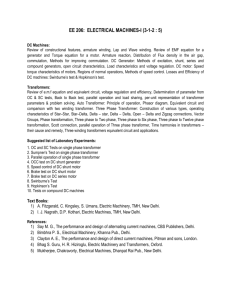
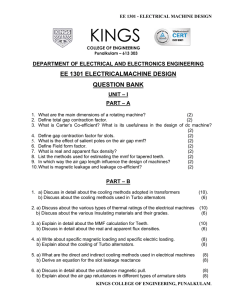
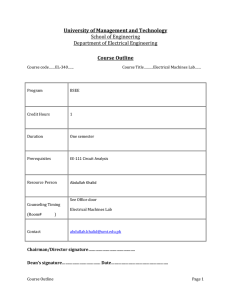
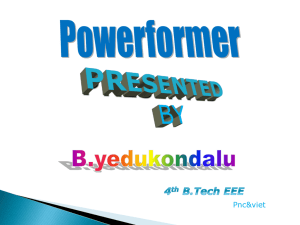


![FORM NO. 157 [See rule 331] COMPANIES ACT. 1956 Members](http://s3.studylib.net/store/data/008659599_1-2c9a22f370f2c285423bce1fc3cf3305-300x300.png)